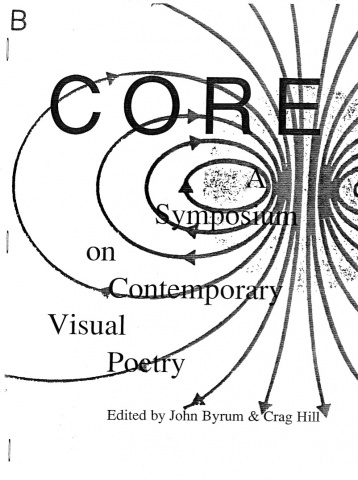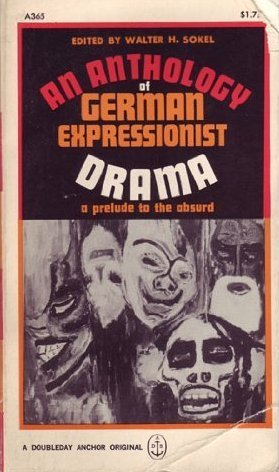John Byrum, Crag Hill (eds.): Core: A Symposium on Contemporary Visual Poetry (1993)
Filed under book | Tags: · concrete poetry, language, literary theory, literature, mail art, poetry, visual poetry

“CORE consists of materials sent in response to a questionnaire on visual poetry developed and distributed by Crag Hill and John Byrum. The questionnaire was distributed to approximately 200 people in several countries whose efforts have been largely concerned with visual poetry. Nearly all of the respondents consider at least some of their literary work as visual poetry or visual literature.
The responses constitute a core sample of the issues, methods, and practices of contemporary visual poetry, and of the respondents’ perceptions regarding its situation within contemporary culture. Respondents were encouraged to deal with the ‘spirit’ of the issues raised by the questionnaire as much as with the particular questions themselves.” (from the Introduction)
Contributions by Johanna Drucker, Charles Bernstein, Dick Higgins, Richard Kostelanetz, Steve McCaffery, Eduardo Kac, among many others.
Publisher Generator Press, Mentor/OH, and Score, Mill Valley/CA, 1993
ISBN 0945112165
156 pages
via imagenigma
Walter H. Sokel (ed.): An Anthology of German Expressionist Drama: Prelude to the Absurd (1963)
Filed under book | Tags: · expressionism, literature, theatre

“The literary upheaval that spread through Europe in the first decades of the 20th century found its distinctive form in German Expressionist drama, one of the forerunners of the modern Theatre of the Absurd. The movement was characterized by revolt against prevailing mores and institutions, an attempt to capture the subliminal suggestiveness of the dream, and by extremism. This anthology, selected by Walter H. Sokel, Associate Professor of German Literature and Humanities at Columbia University, illustrates the common preoccupations and the strikingly different techniques of the movement. Among the plays are:
Reinhard Sorge’s The Beggar, Carl Sternheim’s ‘comedy’, The Strong Box, two plays by the expressionist painter Oskar Kokoschka, Murderer the Women’s Hope and Job, Georg Kaiser’s Alkibiades Saved, Walter Hasenclever’s Humanity, Yvan Goll’s The Immortal One, and Rolf Lauckner’s Cry in the Street. The last play, Brecht’s Baal (appearing here for the first time in English in a translation by Eric Bentley and Martin Esslin) clearly indicates the direction to be taken by Brecht himself, and by others, and points the way to the spirit of Camus, Genet, and the nihilism of the mid-century.
Four manifestoes on their art by Kaiser, Ludwig Rubiner, Paul Komfeld, and Goll preface the collection, and in his detailed Introduction, Professor Sokel explores the social and literary origins of the works and interprets the playwrights’ aims and techniques to give a clear and comprehensive definition of the genre.” (from the back cover)
Translated by Walter H. Sokel, Joseph Bernstein, Michael Hamburger, Jacqueline Sokel, Maurice Edwards, Valerie Reich, Bayard Quincy Morgan, Eric Bentley and Martin Esslin
Publisher Anchor Books, Doubleday, Garden City/NY, 1963
367 pages
via leninbert
Review: Leonard Quirino (Modern Drama, 1965).
PDF (16 MB)
Comment (0)Peter Bürger: Theory of the Avant-Garde (1974–) [DE, EN, ES, PT, CZ]
Filed under book | Tags: · 1920s, aesthetics, art, art criticism, art history, art system, art theory, avant-garde, collage, literary theory, literature, modernism

“In this volume, Peter Bürger formulates a theory of the ‘institution of art’. He argues that the social status of literature and art cannot be explained by making simple, direct links between the contents of individual works and social history. Rather, he holds, it is the social status of art, its function and prestige in society, that provides the connection between the individual art work and history. Bürger’s concept of the institution of art establishes a framework within which a work of art is both produced and received.
The French and German literary and visual avant-garde of the 1920s provides the test of Bürger’s theory. Focusing on the role of the artistic manifesto and, particularly, on the collage as an art form, he shows how avant-garde movements questioned the autonomous, self-referential status of art in bourgeois society and thus represented a radical break with the aestheticism of high modernism. Bürger attacks metaphysical aesthetics and argues instead for a materialistic aesthetic theory for today, one that is rooted in the reality of the social sphere. His theory calls into question any conventional concept of art derived from Romantic notions of organic unity.
Theory of the Avant-Garde provoked such discussion in Germany that its publisher, Suhrkamp Verlag, issued a book of responses that was more than twice the size of Bürger’s own book.” (from the back cover)
German edition
Publisher Suhrkamp, Frankfurt am Main, 1974
Second edition, 1993
147 pages
English edition
Translated by Michael Shaw
Foreword by Jochen Schulte-Sasse
Publisher University of Minnesota Press, 1984
Theory of History and Literature series, 4
ISBN 0816610673
134 pages
Reviews: Benjamin Buchloh (Art in America, 1984), Leah Ulansey (MLN, 1984), Daglind Sonolet (Telos, 1984), Michael T. Jones (German Quarterly, 1986), Martin Vrba (A2, 2016, CZ).
Publisher (DE)
Publisher (EN)
Publisher (CZ)
Theorie der Avantgarde (German, 2nd ed., 1974/1993, updated on 2020-10-13)
Theory of the Avant-Garde (English, 1984, assembled from various sources, no OCR, updated to full version on 2014-5-12 via Charles, updated to OCR version on 2016-1-23 via a2, 12 MB)
Teoría de la vanguardia (Spanish, trans. Jorge García, 1987), 3rd edition (2000, 51 MB)
Teoria da vanguarda (Portuguese, trans. Ernesto Sampaio, 1993)
Teorie avantgardy (Czech, trans. Václav Magid, 2015, added on 2020-4-5)
See also Bürger’s essay Avant-Garde and Neo-Avant-Garde: An Attempt to Answer Certain Critics of Theory of the Avant-Garde, 2010.
Comments (4)
